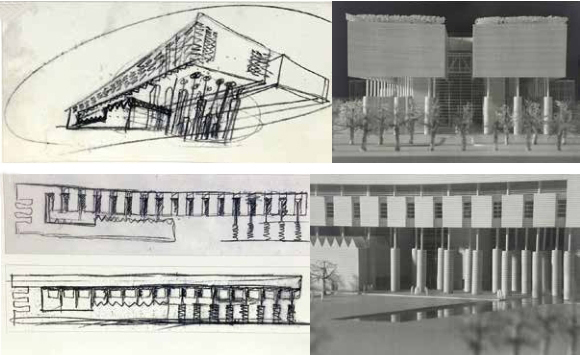Author: Ge Xiuzhi, Zhang ShuSource: Tsinghua University Art MuseumPublished on: 2016-09-15


Ge: Did your estimate the bidding result that your design stood out among others in 2003? What’s your special points making your design win in that stinging bidding?
Botta: Architects have become accustomed to the failing in the building bids and it will be like an unexpected gift from the god to them when they win the bids. The basic idea behind my design of art museum is that the huge vertical stairway is extended from its bottom up to the top floor of exhibition gallery. The staircase is like the center where people can see the ceiling when standing on the stairs and enjoy the lighting from the ceiling. And, my thoughts to design a structure with gradually open shape from the bottom to top. Despite that I had built many buildings with a single central space before, that’s my first attempt to build another space in an empty center.
Ge: As a designer of many world-class museums, please talk about the design differences between a university museum and normal one? How did you make it coordinate with the overall planning of tsinghua university in your design?
Botta: Absolutely, there are different kinds of museums in the world: permanent collection museum, temporary collection museum and theme museum, etc. Great museums should enhance the positions by satisfying their functions in the best way. Besides, the university museum essentially should be an eclectic building. However, it should also be inclusive in some way because it must go back to the building and its history of construction as well as the cultural context of activities related to the modern life. I think that the museum should provide different units (each has its own positioning) and it can be characterized according to the theme exhibition space, therefore, the diversity of exhibition is very important. The Tsinghua University Art Museum is located near historic building area in the campus, next to the main office building. As the east wing of the main office building, I wish to make this museum a part of whole campus.
Ge: As an art museum, its exhibition and display space may occupy a large proportion. What are your considerations in the design of exhibition hall?
Botta: My experience has taught me that there will never be enough space for exhibition and domination. It’s important for the exhibition to have enough spaces, which means that a transition space between the visitots’ daily lives and iconic significances. The space needs not only the necessary size, but also the special light, the peaceful atmosphere and the close relationship between visitors and exhibits.
Ge: There are the colonnade of several meters high and sailboat-shaped hall at the entrance in your design. What does it mean?
Botta: The great colonnade at the entrance can create an autonomous space with its own quality and images. I regard it as a porch where a huge group of columns represent a temple column and visitors can find external space in the museum that shows its existence and value.
Ge: What are the difficulties during the construction process? Is there any dissatisfaction with the completed building?
Botta: The process of a completed building is to ‘transform the natural environment into a cultural environment’, and it can be regarded as the expression of artistic work. Therefore, there are both satisfaction and difficulty. For the art museum in Tsinghua University, the main difficulty I encountered in the construction process is the selection of materials. Unfortunately, we had to give up the original idea of the ceiling and wall with planks and use metal materials instead because of the fire protection.